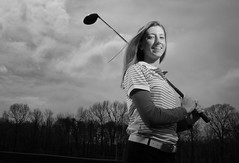 Last week I went to Severn, Maryland to photograph a young female golfer who is sixteen year-old sophomore in high school.
Last week I went to Severn, Maryland to photograph a young female golfer who is sixteen year-old sophomore in high school. She competes on the men's team and drives form the mens' tees. Before you start feeling sorry for her, she drives 240 and recently shot a 68 on a par-72 course. She can bring it.
I was shooting her for The Sun, and decided to do the job with my Canon G9. That little point-and-shoot might not look like much compared to the other guys' Nikon D2xs and D2Hs bodies, but it does some neat things that makes it very useful as an always-with-you camera.
I usually will do anything I can to hedge my bets or improve my odds before I even get to an shoot, and this time was no exception. The assignment gave me the basic details, and told me to meet Kaitlyn and her coach at the school's baseball diamond after school let out.
Baseball diamond?
Surely we can do better than that. So the first thing I did was to call her school's athletic director (the only contact number I had) and leave a message asking if we could meet at a local golf course instead.
But I was getting no love from the AD, who never did get back to me before the assignment. Thus the headline for this post. But you at least try.
So I decide to go with Plan B, which is to go with the only setting I had available, and knock it down some by using flash to raise up the relative values on my subject.
Problem is, the assignment was for 2:30 in the afternoon, so I was going to need a lot of watt-seconds to overpower daylight -- or a fast sync speed to make my speedlights appear to be more powerful. Which is why I decided to shoot the assignment on my Canon G9.
It'll sync up to 1/2500th of a second without using any kind of a power-sucking FP mode. You just have to tweak it a little so the camera does not know to limit it's shutter to 1/500th of a sec for flashing.
It makes nice files, too. It's 12 megapixels, but the smaller chip size means there is some inherent noise because of the pixel density. So I tend to think of it as an equivalent of an 8MP chip for blow-up purposes and not stretch those pixels out too far.
Anyway, it shoots as low as ISO 80, 1/2500th of a sec at f/8. Which, if you go with the "sunny-16" rule, tells you that it can sync a flash while underexposing daylight roughly three full stops. So it's got that going for it. Which is nice.
But I'm never one to just go with the math -- I like to test things. You know, see them for myself.
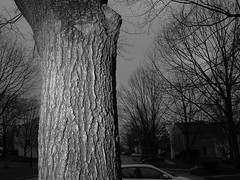 So I went out into the
So I went out into the The next day, when I got to the baseball diamond that would have to substitute for a golf course, I found a shooting direction that would give me a good tree line. The baseball diamond is still there, of course, but I was gonna drop it down to not be so noticeable. I am shooting into the sun, on a partly cloudy / sunny day.
I like shooting into the sun when I am lighting, as the sky can look really cool when you knock it down. Also, your subject is in shadow, which makes them easier to light and they are not squinting into the sun.
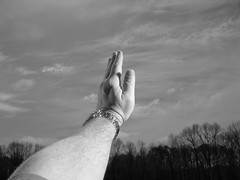 As is usually the case, my stand-in while I waited for Kaitlyn was my left hand. It has proved to be a dependable lighting model, if not a muse, for many years.
As is usually the case, my stand-in while I waited for Kaitlyn was my left hand. It has proved to be a dependable lighting model, if not a muse, for many years. I cranked my ISO down to 80, and my shutter to 1/2500th (that is so sweet) and dialed in the sky exposure I wanted via the aperture. Nothing technical -- just chimping and looking at my screen on back.
Why this way? ISO 80 gives me the best image quality, which is especially important on a small-chip camera. And the 1/2500th shutter speed meant that I could use the biggest aperture opening possible for ease of flash balancing.
The sky looked best at 1/2500th at f5. Next step is to adjust the flash to give me a good exposure on my hand at f/5. I stuck a Nikon SB-800 on a stand, and softened it a little with a LumiQuest Soft Box II. From about 6 feet away, my hand looked good at about 1/4 power. I synched it with two daisy-chained SC-17 cords -- one neutered and one straight.
So, now I have my shooting aperture, shutter speed, ISO and main light power level all ready to go. Takes way longer to write about it than to do it, actually.
But want a little separation light, too, so I stick a second SB-800 opposite the main light, set to slave with the SU-4 hack. It was pointed pretty close to right back in my lens, so I gobo'd it off with a Honl shorty snoot.
By the way, I have become a big fan of speed straps and will be doing a piece on them (and how to make them) very soon.
This was set at 1/16 power, based solely on the way it looked hitting the left side of my hand in the shooting position. Speaking of shooting position, I always use a marker on the ground for consistency when I am setting up light before a subject arrives. Makes stuff much less complicated.
So, now I'm all set when she gets there.
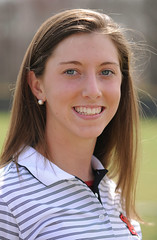 When she arrives, I back myself up with a quick mug shot right off the bat. For this, I used a Sigma 50-150/2.8 on a Nikon D300.
When she arrives, I back myself up with a quick mug shot right off the bat. For this, I used a Sigma 50-150/2.8 on a Nikon D300. Why the backup shot, different body and different lens? Lotsa reasons. It is insurance against a bad card, bad camera and/or a malfunctioning lens. Or if something happens and she (or I) have to go before we do the lit shot. Also, it gives the paper a file mug for later, when she shoots a double-eagle and we are not there to see it.
From here on out, everything is easy. As far as the technicals are concerned, she is pretty much the tree in my front yard. No surprises, no complex thinking. I can relax, get her to relax (which is more important) and shoot. I did make one adjustment -- she was a little bright so I dropped my shooting aperture a third of a stop down, to f/5.6. No big whup.
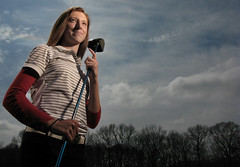 I shot about 45 frames, in B&W and color. I knew it was going to run in B&W inside the sports section, but shot color to have some just in case. They always convert the color originals to B&W, but I think the stuff shot in B&W looks better. Plus, shooting some frames in B&W first helped me to visualize it better for after the conversion.
I shot about 45 frames, in B&W and color. I knew it was going to run in B&W inside the sports section, but shot color to have some just in case. They always convert the color originals to B&W, but I think the stuff shot in B&W looks better. Plus, shooting some frames in B&W first helped me to visualize it better for after the conversion.You can still see the home run fence in the top photo, but it is very much muted. You can't clone it out for the paper, either. That's a real ethical no-no. Fortunately, the paper's repro quality (or lack of it -- we print on Charmin) is such that will mute the line even more if not kill it altogether.
Finally, if you get a chance, take a look at it the top photo bigger, or even full-sized. (Not even full-sized, actually, as I cropped it a little.)
That Canon G9 is a trusty little always-there sidekick that's currently going through the PJ ranks like a hot knife through butter. You can shoot real assignments with it, do amazing stuff with your suddenly-more-powerful flashes, record audio and even shoot full video for the web. That's a lot to like.
 Here is the location kit I put together, packed for easy travel and opened up to show what's there. in a waist pack and with minimal shoulder wear-and-tear, I have a high-sync body with a a whole range of lenses, three light sources (SB-800's) with stands, grids, gobo's, umbrella, gels, etc., and SC-17 sync cords for close work. It's ridiculous how much you could do with something that takes up so little space and weight.
Here is the location kit I put together, packed for easy travel and opened up to show what's there. in a waist pack and with minimal shoulder wear-and-tear, I have a high-sync body with a a whole range of lenses, three light sources (SB-800's) with stands, grids, gobo's, umbrella, gels, etc., and SC-17 sync cords for close work. It's ridiculous how much you could do with something that takes up so little space and weight.NEXT: Controlling Daylight, Pt. 1




0 comments:
Post a Comment